
a web page by Don Roberson |
EURYLAIMID BROADBILLS Eurylaimidae
|
||||||
|
||||||
Broadbills are spectacular but often are exceptionally difficult to see. This combination makes them perhaps my favorite family of birds. I mean — my two favorite families of birds! Molecular evidence (Moyle et al. 2006) reveals that two lineages of broadbills diverged about 55 million years ago and have been on separate evolutionary paths since then. One lineage evolved into the green broadbills of Asia and some African broadbills (the Calyptomenidae) while the other lineage had more branches. A New World species (Sapayoa) split off ~52 million years ago, then the Asities of Madagascar ~46 mya (Prum 1993), leaving a set of mostly Asian broadbills (including Wattled Broadbill) plus Grauer's Broadbill in Africa (more on that below). |
||||||
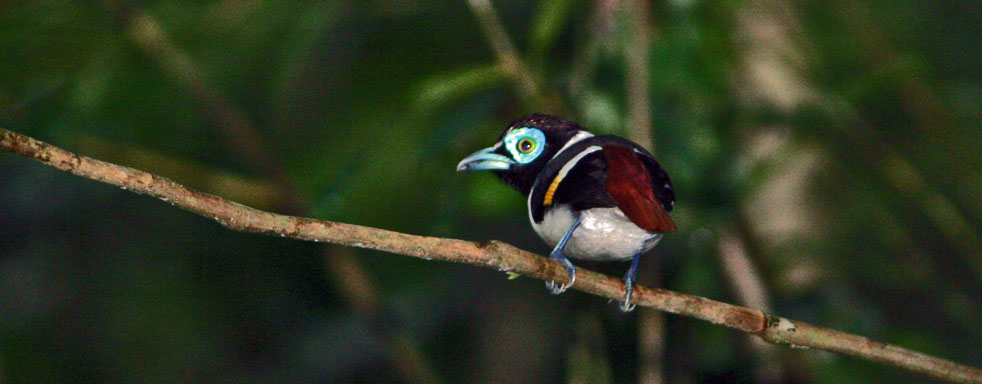 |
||||||
|
||||||
|
||||||
The nests of all broadbills are similar, consisting of a suspended ball or bag of grass, leaves, rootlets, vine tendrils, and other plant and animal material with a thin extension dangling beneath. Female eurylaimids lay 1 to 8 eggs. Apparently, both male and female parents share in nest construction, incubation, and provisioning of the young. They build elaborate, hanging, purse-shaped nests. Black-and-red Broadbill (above) drapes its nests over quiet forest backwaters and streams, and can often be found around the water's edge (Bruce 2003). Those species with huge bills use them to capture a wide variety of insects, arthropods, and small vertebrates like frogs, lizards, and even fish. Smaller species, such as Black-and-yellow Broadbill (right; a female with an incomplete breast band) also catch flying insects by sallying out from the subcanopy. Asian broadbills are generally located by their calls. That of Black-and-yellow Broadbill (right) is a very unusual, accelerating cacophony that proves to be a characteristic sound of the Bornean lowland forest. Once learned, this species proves to be quite common. Yet it usually remains difficult to actually see its lovely mix of pink, yellow, and black patterns. |
||||||
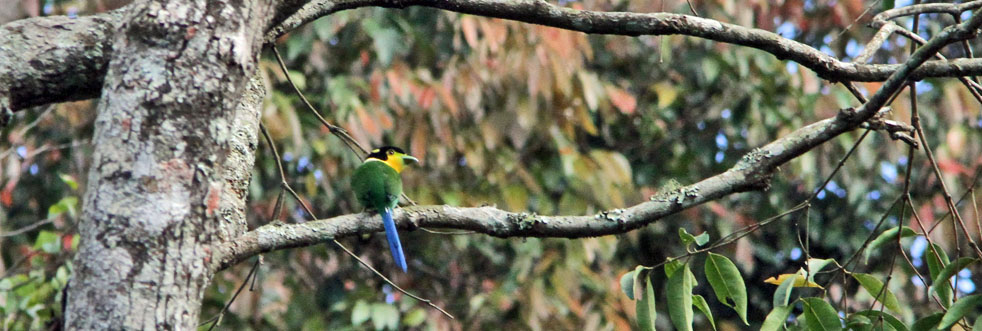 |
||||||
Eurylaimid Broadbills live in the subcanopy of the Old World tropics: 8 species in southeast Asia, the Philippines, Borneo and Sumatra, plus one in central Africa. Most are lowland birds although some are highland species, such as Long-tailed Broadbill of southeast Asia and the Greater Sundas (above and below left). Long-tailed Broadbill can almost look like a painted Chinese doll (below left). In Danum Valley, Borneo, both Banded and Black-and-yellow Broadbills proved to be much less rare than supposed once their calls were learned, but they still prove frustratingly difficult to locate in the leafy forest above. When seen, Banded Broadbill wore a subtle mix of gray, yellow, and maroon-red (below right). |
||||||
|
||||||
Grauer's Broadbill (sometimes called African Green Broadbill) is the only Eurylaimid Broadbill in Africa (left in a wonderful photo by David Fisher of an adult at its nest). It is endemic to the Albertine Rift at the intersection of Congo, Uganda, and Rwanda. It is amongst the most sought after birds in Africa. It has recently been found regularly in Mbwindi Swamp in Bwindi-Impenetrible Forest park in southwest Uganda. David Fisher's photo is from that locale; researchers took his group to two nests in July 2006 [David's photo is actually a combination of two shots — the nest and the bird carrying food]. Unfortunately, I missed it on my own day visit there several years earlier, despite having a local expert guide. My guide had found a nesting pair just a couple months before but the young had just fledged and the birds dispersed. It does not have the broad bill of other species but looks rather like a tiny green puffbird sitting quietly in the forest canopy. Unlike other broadbills, graueri has a thin, soft, high-pitched note. Grauer's Broadbill diverged from the Asian broadbills in this group about 35-45 million years ago, but is more closely related to them than anything else (Moyle et al. 2006). Asities and Sapayoa are more ancient lineages along this same evolutionary branch. Thus its lineage is less ancient than the Calayptomenid Broadbills, Asities, or the Sapayoa. There is such diversity of shape, size, bill, and colors that the 9 species in the Eurylaimid Broadbills are currently assigned to six separate genera: Cymbirhynchus [Black-and-red Broadbill], Psarisomus [Long-tailed Broadbill], and Pseudocalyptomena [Grauer's Broadbill] have photos here. The other two monotypic genera are Serilophus — for Silver-breasted Broadbill S. lunatus, a small silver-and-rust broadbill ranging from India to China and Myanmar — and Corydon, for Dusky Broadbill C. sumatranusis of southeast Asia and the Greater Sundas. The latter is a strange dark bird with a huge pink bill and a pale “bib.” Its is more elongated that other broadbills, and it forages like a roller, foraying from a perch. It is the most social of the broadbills, and is often found in noisy groups. Only genus Eurylaimus has multiple (4) species: Banded, Black-and-yellow, and Wattled Broadbill have photos here. Visayan Broadbill E. samarensis, of Samar, Leyte and Bohol in the central Philippines, is a recent split from Wattled Broadbill. |
||||||
Photos: The Wattled Broadbill Eurylaimus (formerly Sarcophanops) steerii was in the PICOP forest of Mindanao Philippines, on 27 Dec 2005. The photo of Roxy Laybourne and a portion of the bird collection at the Smithsonian's Museum of Natural History is © Chip Clark many years ago, then published in the April 2016 issue of Smithsonian magazine, and reposted on the Smithsonian's web page [used here under the "fair use" doctrine]. The Black-and-red Broadbill Cymbirhynchus macrorhynchus was at Borneo Rainforest Lodge, Danum Valley, Sabah, Malaysian Borneo, on 8 Aug 2003; the video caps of the same bird were taken from Rita Carratello's video. The Black-and-yellow Broadbill Eurylaimus ochromalus was along the boardwalk to Deer Cave, Mulu NP, Sarawak, Borneo, on 21 July 2003. Both photos of Long-tailed Broadbill Psarisomus dalhousiae were taken in Kaeng Krachan NP, Thailand, on 23 Dec 2012. The Banded Broadbill Eurylaimus javanicus was at Khao Yai NP, Thailand, on 25 Dec 2012. David Fisher photographed the Grauer's Broadbill Pseudocalyptomena graueri and its nest in Bwindi-Impenetrable Forest NP, Uganda, in July 2006. All photos © Don Roberson; except those attributed to © Rita Carratello and © David Fisher, used with permission, and © Chip Clark ("fair use"); all rights reserved. Family book:
The Handbook of the Birds of the World volume that covered this family (Bruce 2003) included, as expected, some spectacular photos. However, it, too, did not anticipate the true nature of the relationships among this group. Literature cited:
|
 It was a steamy day in the Philippine lowlands of eastern Mindanao. It had rained heavily during our two-hour jeep ride to a remnant forest, and then we'd been walking for hours, taking cover with each passing rain-shower. By late morning our little group was strung out along a half-abandoned logging road, trudging uphill for some time, and then down into a little swale. I was alone between segments of our party when suddenly I "felt" like something was watching me to the left. I stopped, turned, and was confronted by this amazing bird (left): a male Wattled Broadbill. This was very high on my "most wanted" endemics from the Philippines and the joy of finding it — or of it finding me — was exhilarating. And to get photos! By then a female appeared (below) as the rest of our group reached the spot, and everyone was very happy.
It was a steamy day in the Philippine lowlands of eastern Mindanao. It had rained heavily during our two-hour jeep ride to a remnant forest, and then we'd been walking for hours, taking cover with each passing rain-shower. By late morning our little group was strung out along a half-abandoned logging road, trudging uphill for some time, and then down into a little swale. I was alone between segments of our party when suddenly I "felt" like something was watching me to the left. I stopped, turned, and was confronted by this amazing bird (left): a male Wattled Broadbill. This was very high on my "most wanted" endemics from the Philippines and the joy of finding it — or of it finding me — was exhilarating. And to get photos! By then a female appeared (below) as the rest of our group reached the spot, and everyone was very happy.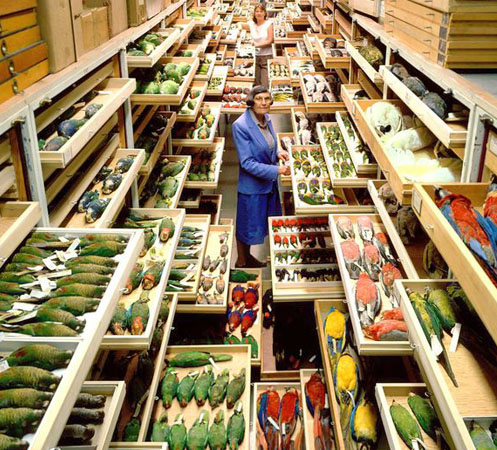 What a spectacular set of birds are the Eurylaimid Broadbills! My first encounters were looking at specimens in major museums. I obtained a research grant to study Pterodroma specimens, including at the Smithsonian Museum (USNM) in Washington, D.C. Among the curators there at the time who helped me was Roxie Laybourne (shown at left), who worked in the USNM collection for over 50 years (Chip Clark's photo was taken 30 years ago for an article in Smithsonian magazine). This photo does not include broadbills, but well illustrates what a top-notch collection looks like. These particular drawers show the range in sizes and colors among four psittacid families: parrots, parrotlets, fig-parrots, lories, cockatoos, and macaws are among the species.
What a spectacular set of birds are the Eurylaimid Broadbills! My first encounters were looking at specimens in major museums. I obtained a research grant to study Pterodroma specimens, including at the Smithsonian Museum (USNM) in Washington, D.C. Among the curators there at the time who helped me was Roxie Laybourne (shown at left), who worked in the USNM collection for over 50 years (Chip Clark's photo was taken 30 years ago for an article in Smithsonian magazine). This photo does not include broadbills, but well illustrates what a top-notch collection looks like. These particular drawers show the range in sizes and colors among four psittacid families: parrots, parrotlets, fig-parrots, lories, cockatoos, and macaws are among the species.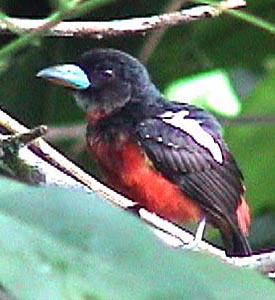
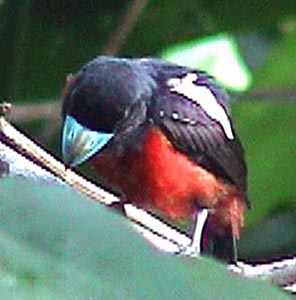
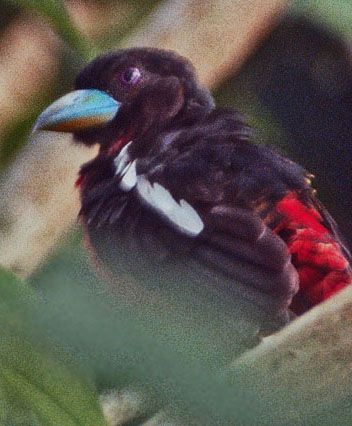
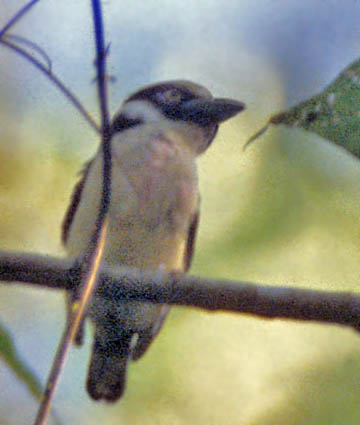
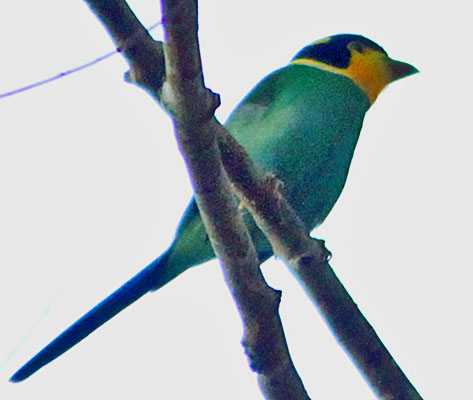
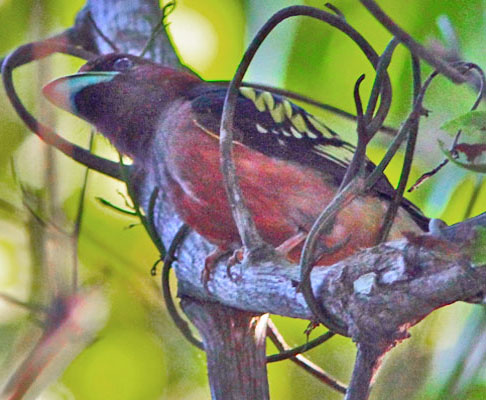
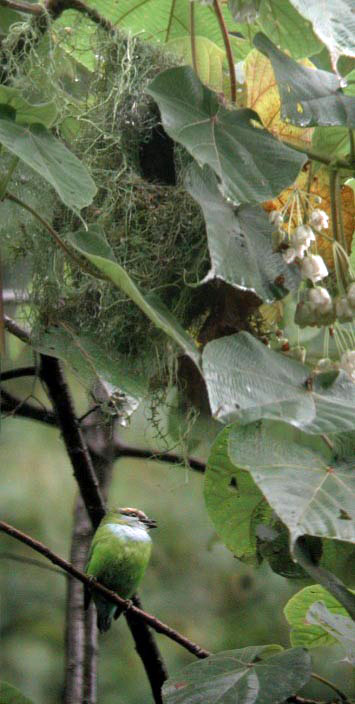 The nests of the Eurylaimid Broadbills — and of Asities and Sapayoa — are globular masses suspended 10-30 cm below a branch, and the entrance is on the side of the nest. In this respect they differ from the Calyptomenid Broadbills whose nest is suspended closer to the branch, and the entrance of which is at the top of the mass (Prum 1993, Moyle et al. 2006).
The nests of the Eurylaimid Broadbills — and of Asities and Sapayoa — are globular masses suspended 10-30 cm below a branch, and the entrance is on the side of the nest. In this respect they differ from the Calyptomenid Broadbills whose nest is suspended closer to the branch, and the entrance of which is at the top of the mass (Prum 1993, Moyle et al. 2006). 